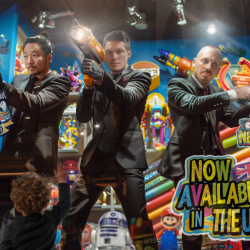Kantar reports that marketers are rapidly falling out of love with TV. And nowhere is this more apparent than in the build-up to Christmas. Remember those halcyon days when the almighty John Lewis Christmas ad signified the start of festivities more than an advent calendar? Those days are gone.
Last year, not a single Christmas TV ad stood out. If John Lewis’ festive fall from grace represents the death of the Xmas TV ad, how else are marketers to mine this seasonal gold mine? Achieving aggressive sales targets while grabbing audiences’ attention amongst competitive noise and minimum disposable income… it’s a conundrum. But a conundrum that can be solved by brand experiences.
Much like the timelessness of Coca-Cola’s Christmas truck experience, festive brand experiences have an ability to drive real and emotional engagement at a time when consumers are eager to participate in the spirit of the season. But it’s all too easy to fall into the trap of offering a pimped-up Santa’s Grotto. It is, however, possible to create unique and memorable festive experiences that drive consumers to purchase without resorting to a bearded man in a red suit. The key lies in putting a seasonal twist on some core brand experience principles:
Magic is possibly the most important element when thinking about Christmas activations. Specifically, the magic that stems from storytelling and surprise. Behavioural science’s Gap Theory tells us that if an experience messes with people’s expectations and leaves gaps for people to solve, they engage more parts of their brains. By providing unexpected magic, brand experiences can exceed these expectations. Not meeting expectations drives a sense of loss. Merely meeting expectations leaves audiences feeling ‘meh’. But exceeding them? This is what drives brand advocacy.
Experiences are the perfect way to engage emotions and senses. The more senses that are involved, the deeper the emotional connection and the more memorable the experience. Sight, touch, sound and smell can all be primed in a face-to-face experience. Smell, as the most ‘primitive’ sensory system, is extremely powerful because of its connection with the limbic system – the place where emotions and memories are formed. This is why wafts of cinnamon and nutmeg instantly evoke Christmas. By capitalising on festive scents, an experience can say Christmas… without literally saying Christmas.
It’s important to recognise that Christmas is celebrated differently around the world
Inclusivity should be embedded at the core of an idea by acknowledging and respecting other religious and cultural holidays that overlap with the season. And by incorporating diversity, the resulting activation will have the added benefit of differentiating itself from the omnipresent bubbles and baubles trope.
The cost-of-living crisis means many consumers are once again tightening their purse strings this year. With this comes a real demand for brands to supply unique social experiences, free of charge. Brands offering experiences that meet a festive need will foster increased engagement, build brand affinity and drive purchase intent. Conversely, the tough economic climate has resulted in empty retail spaces that are ripe for cost effective pop-ups.
Christmas is a joyous and playful time. So it’s the perfect opportunity to tap into people’s love of social gamification by ensuring an activation entails maximum levels of interaction. Experiential marketing centres on involving consumers in the brand, as supported by the behavioural science theory of co-creation, whereby an experience is more likely to be remembered if participants physically interact or co-create around it.
So highly interactive and immersive experiences that involve ‘an exchange’, are more rewarding and more likely to stand out in a Christmas crowd.
As confirmed by a YouGov survey, time spent with loved ones tops Brits’ lists of festive priorities. Brand experiences can tap into this desire by designing activations that allow families and friends to enjoy themselves as a group, and consumers to share in the experience with others. And because research shows that new customers at Christmas are less valuable long-term, use festive experiences to reward loyal customers.
Christmas is a peak time for bringing people together; a principle that applies to marketing as much as families. So rather than helplessly watching the big festive blockbuster TV ad slide into cultural irrelevance, let’s instead look at more joyous IRL ways for brands to connect with their audiences during this incredibly special — and potentially lucrative — period.
Feature image: Ksenia Yakovleva / Unsplash


























